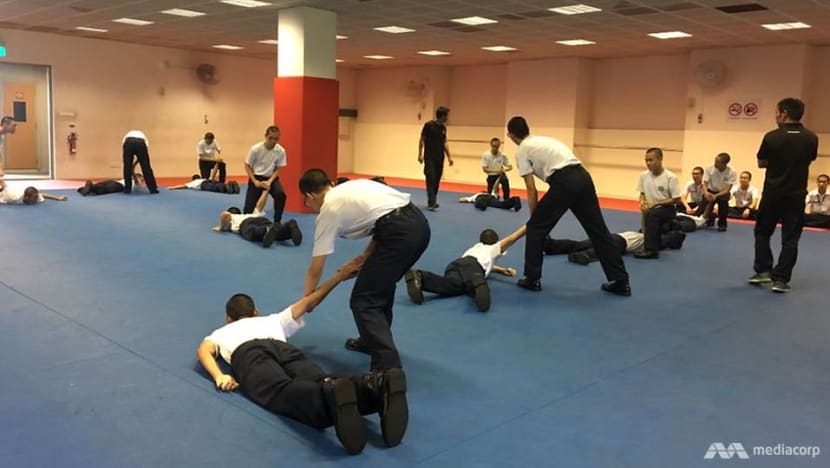Shooting Tasers and martial arts techniques: How the police make arrests

A condensed training course in a rare behind-the-scenes look on how the Singapore Police Force makes arrests. (Photo: Lee Li Ying)
SINGAPORE: Arresting subjects is a part and parcel of police work – but the men in blue don’t have it easy. In a video that went viral last year, a drunken Australian man, 44-year-old Jason Peter Darragh, was seen taunting two police officers in Changi Airport while they tried to apprehend him.
He was eventually subdued with the help of passers-by, but the video prompted netizens to question how the police were trained and whether they were competent enough to handle weapons like batons.
The Singapore Police Force has arrested 49,868 people in the past three years. Figures from the police also showed there were 412 cases of officers suffering physical hurt and verbal abuse in the course of their work last year, compared with 314 cases in 2015.
To help the media better understand the challenges the officers faced on the ground, reporters were invited to attend a condensed training course in a rare behind-the-scenes experience.
MASTERING THE BASIC TECHNIQUES
The day started early on May 16 at the Home Team Academy. After a quick warm up, journalists were paired up and taught commonly used martial arts techniques - such as the rear wrist lock and the arm bar takedown - that can be used to quickly take control of another person.
While the instructors made everything look effortless, my fellow colleagues and I were failing spectacularly – putting pressure on the wrong spots and twisting arms the wrong way.
After a few stumbling efforts, we were taught to use handcuffs. Even with another reporter who gamely remained still while I learned how to cuff her, I struggled to operate the cuffs properly.
It proved quite challenging to keep her wrist locked in a way such that she would be immobilised, while holding on to the cuffs in the proper manner. It took several tries before I got the hang of it.
We got to put our newly acquired skills to the test when the instructors threw us a challenge. An experienced police officer played the role of a drunk man causing public nuisance in a mock scenario, and our jobs were to arrest him.
I was paired up with three other reporters. For 20 long minutes, he slipped through our various attempts to grasp his arms and trip his legs. Even when we eventually got him to the floor, he refused to surrender his arms, stubbornly pinning them to his sides.
Eventually, the instructors had to step in to help before the handcuffs went on.
This is a real scenario that officers face on the ground.
Mr Raymond Lo, commanding officer of the Frontline Policing Training Centre, shared that non-compliant subjects can demonstrate passive resistance, active resistance and can even be outright violent.
“We do have a few cases where the subject can turn violent all of a sudden or is violent from the very onset ... Police provides very comprehensive training for both our recruits and our in-service officers in the use of force.
"The use of force ranges from verbal commands to use of Tasers and then combat and even firearms.”
He added that the situation on the ground is often dynamic, and officers often have to make split-second decisions.
“If you think about it, the aggressor often has the first-mover advantage, because they have to exhibit some level of aggression before officers will react,” added Mr Lo.
USING WEAPONS
At the session, reporters were also given the opportunity to shoot Tasers loaded with training cartridges. When a fully operational Taser is fired correctly, two probes are embedded in the subject’s skin, delivering 50,000 volts of electricity to momentarily stun a target.
Instructors taught us to aim such that one probe would land on the subject’s upper abdomen and the second probe will land on the subject’s upper thigh.
We were told that the Tasers are not usually used on moving targets, as the probes could either miss, or worse, land on sensitive regions of the body such as the face or chest.
With many tools at their disposal, officers are taught to use the appropriate amount of force.
“The officers will have to consider many factors, the things like the number of officers they have for the particular incident, the crowd size, the profile of the subject - whether they are petite or whether they are big built and also, their age,” said Mr Lo.
Mr Lo added that communication skills are also important when officers are dealing with suspects. “We want them to use their soft skills, engage the other party and get their agreement, their commitment to follow instructions,” he said.












